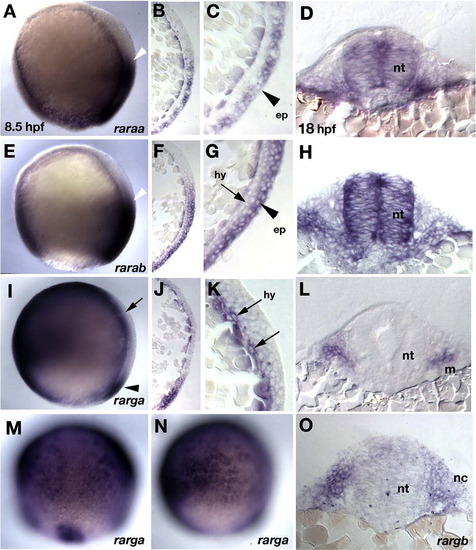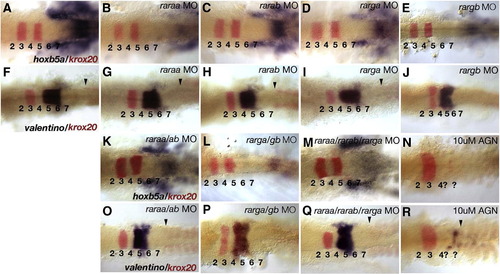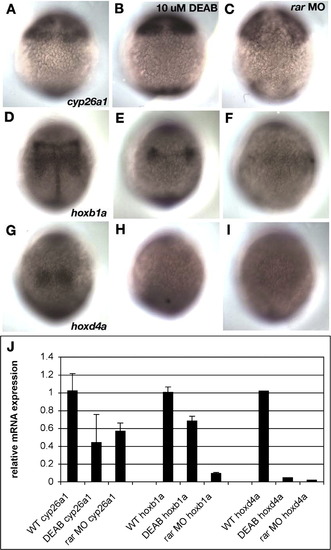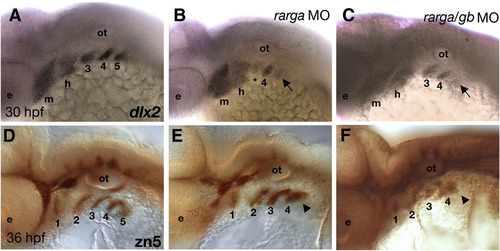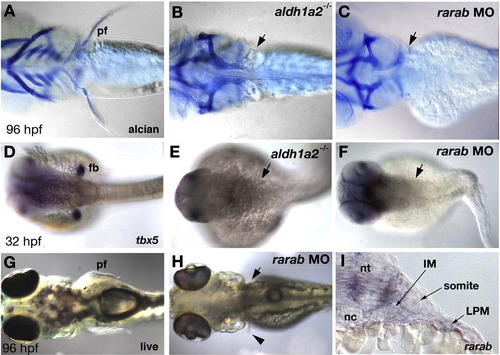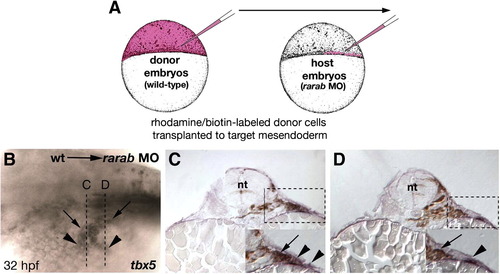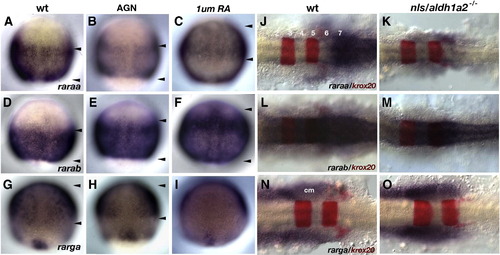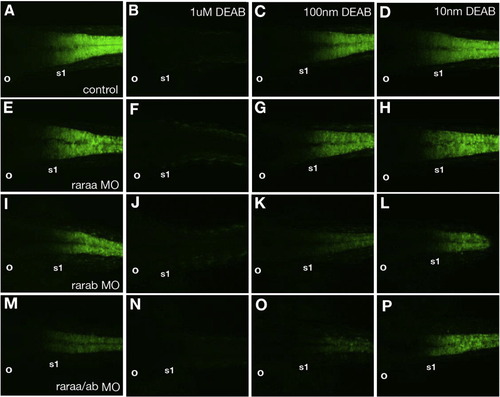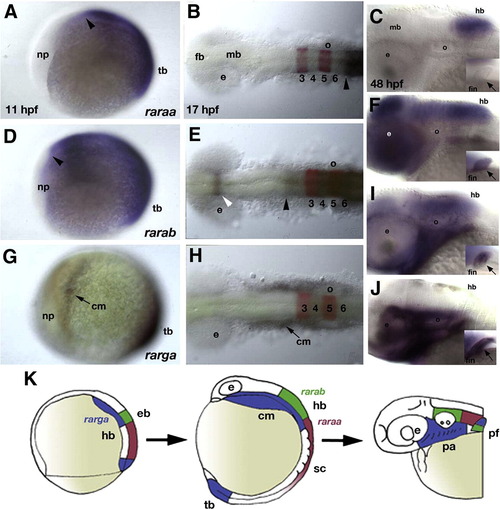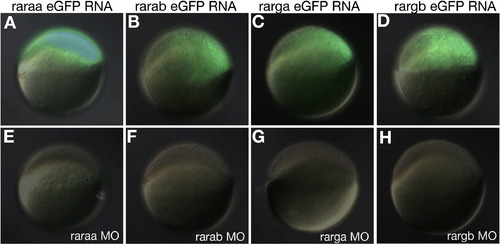- Title
-
Combinatorial roles for zebrafish retinoic acid receptors in the hindbrain, limbs and pharyngeal arches
- Authors
- Linville, A., Radtke, K., Waxman, J.S., Yelon, D., and Schilling, T.F.
- Source
- Full text @ Dev. Biol.
|
Germ layer-specific expression of zebrafish rars. In situ hybridization in whole mounts (A, E, I, M, N) and parasagittal sections (B, C, F, G, J, K) at 8.5 hpf (90% epiboly), and transverse sections at 18 hpf (18 somites) at hindbrain levels (D, H, L, O). (A–D) raraa. (A) Expression is in posterior ectoderm in the gastrula, with an anterior border in the presumptive hindbrain (white arrowhead). (B–D) Sections reveal that expression is restricted to epiblast, shown at higher magnification in panel C (arrowhead), and persists in the neural tube (D). (E–H) rarab. (E) Expression is in posterior ectoderm in the gastrula, with an anterior border in the presumptive hindbrain (white arrowhead), similar to raraa. (F–H) Sections reveal strong expression in epiblast (arrowhead in panel G), weaker in hypoblast, which persists in the neural tube and pharyngeal arches (H). (I–N) rarga. (I, M, N) Expressed anteriorly and ventrally during gastrulation and at the dorsal margin (arrowheads in panels I and M). Panel M shows a dorsal view and panel N is focused laterally to show expression in ventral epiblast (presumptive epidermis). (J–L) Sections near the dorsal side reveal expression restricted to the hypoblast (arrows in panel K) and later in cranial mesoderm (L). (O) rargb. Expression is ubiquitous at early stages (not shown), and by 18 hpf sections reveal expression in pharyngeal arch mesenchyme. Abbreviations: ep, epiblast; hy, hypoblast; m, mesoderm; nc, neural crest; nt, neural tube. EXPRESSION / LABELING:
|
|
Redundant requirements for rars in hindbrain patterning. Dorsal views of flat-mounted hindbrains at 15 hpf (12-somite), anterior to the left, labeled by two-color in situ hybridization for either hoxb5a/krox20 (A–E, K–N) or valentino/krox20 (F–J, O–R). Hindbrain rhombomeres are numbered (1–7), arrowheads indicate the location of the first somite. (A, F) Controls. (B–E) Embryos injected with MOs targeting raraa (B), rarab (C) rarga (D) or rargb (E) show reduced hoxb5a expression in posterior neural tube and mesoderm (blue), but no defects in krox20 expression in r3 or r5 (red). (G–J) Embryos injected with each of the four MOs alone show no defects in valentino (val) expression, or in the position of somite 1 (arrowheads). (K, L) Combined injection of raraa and rarab MOs (K; N = 22), or rarga and rargb MOs (L; N = 25) causes a reduction in hoxb5a expression. (M) Combined injection of the rarga MO with both raraa and rarab MOs (N = 25) causes severe reduction in hoxb5a expression in the neural tube, but mesodermal expression persists. These triple morphants retain the r5 stripe of krox20 expression unlike embryos treated with a pan-RAR antagonist, AGN 193109 (N). (O–Q) raraa/rarab double morphants (O; 35/38), rarga/rargb double morphants (P; N = 20), and raraa/rarab/rarga triple morphants (Q; N = 22) all show slight reductions in val expression, while its expression is almost completely eliminated by AGN treatments (R; N = 25). EXPRESSION / LABELING:
|
|
Depleting all four rars eliminates hox expression in the hindbrain. (A–I) Dorsal views of late gastrula stage embryos (8.5 hpf), labeled by whole mount in situ hybridization for cyp26a1 (A–C), hoxb1a (D–F), and hoxd4a (G–I). Anterior is to the top. Controls (left column), DEAB-treated (middle column) or quadruple morphants (rar-MO) injected with MOs targeting raraa, rarab, rarga and rargb. (J) Histogram summarizing results of quantitative PCR (qPCR) to detect relative amounts of the same three gene products, using RNA isolated from the siblings of embryos used for panels A–I. (A–C) No changes were detected in the pattern of cyp26a1 expression in presumptive forebrain and midbrain in DEAB-treated (B) or rar-MO quadruple morphants (C), but total levels were significantly reduced in both cases (J). (D–F) hoxb1a expression in presumptive hindbrain was dramatically reduced by DEAB treatments (E) and eliminated by rar-MO (F), and this was confirmed by qPCR (J). (G–I) hoxd4a expression was virtually eliminated by both DEAB treatments (H) and rar-MO (I), which was confirmed by qPCR (J). EXPRESSION / LABELING:
|
|
Depletion of rarga alone disrupts posterior pharyngeal arches. Lateral views, anterior to the left. (A, D) Controls. (B, E) rarga morphants (C, F) rarga/rargb double morphants. (A–C) Whole mount in situ hybridization to detect dlx2 mRNA reveals reductions in migrating neural crest cells in arches 3–5 (arrows) in both single (B; 28/30) and double (C; 35/35) morphants. (D–F) Whole mount, immunostaining with the zn-5 antibody reveals reductions in the pharyngeal pouch endoderm (particularly pouch #5, arrowheads) in these arches, but no defects in zn5+ cells in the hindbrain or cranial ganglia in single (E) and double (F) morphants. Abbreviations: e, eye; m, mandibular; h, hyoid; ot, otic vesicle. |
|
Depletion of rarab alone disrupts pectoral fin budding. (A–C) Alcian blue stained cartilage in larvae (4 dpf). Ventral views, anterior to the left. (A) In controls the pectoral fins protrude laterally just posterior to the skull. (B, C) Lack of fins and fin cartilages in both aldh1a2 mutants (B, arrow; N = 12) and rarab morphants (C, arrow; N = 24). (D–F) tbx5 expression at 32 hpf, detected by whole mount in situ hybridization. Dorsal views, anterior to the left. (D) In controls, tbx5 labels the bilateral pair of early pectoral fin buds, which are absent in aldh1a2 mutants (E, arrow) and rarab morphants (F, arrow; N = 7). (G, H) Live 96 hpf larvae, dorsal views, anterior to the left. rarab morphants occasionally form a small pectoral fin on one side (H, arrowhead). (K) Transverse sections at forelimb levels at 24 hpf reveal rarab expression in the neural tube and lateral plate mesoderm, but absent from the adjacent somite or intermediate mesoderm. Abbreviations: fb, fin bud; IM, intermediate mesoderm; LPM, lateral plate mesoderm; pf, pectoral fin; nc, notochord; nt, neural tube. |
|
Grafts of wild-type mesoderm rescue tbx5 expression in rarab morphants. (A) Cell transplantation technique. Donor embryos were injected at the one-cell stage with both a fixable biotinylated dextran and a fluorescent rhodamine-dextran (red). Hosts were simultaneously injected with the rarab MO. At 4 hpf small groups of cells were transferred from donors to the margin (which forms the mesendoderm) of hosts, which were raised to 32 hpf, and stained for biotin (brown, grafted cells) and tbx5 (blue, pectoral fin). (B) Whole mount, anterior to the left, showing partial unilateral rescue of tbx5 expression — arrowheads indicate tbx5-expressing cells, and arrows indicate locations of wild-type, donor cells. Rescue was either partial (15/50) or completely restored the fin (2/50). Dotted lines indicate locations of transverse sections in panels C and D. (C, D) Transverse sections through the fin fields of mosaic embryos, showing the absence of tbx5 expression on the untransplanted, left side and tbx5+ cells in the LPM (arrowheads) on the right side in close proximity to biotin-labeled, donor cells (arrows). Abbreviations: nt, neural tube; wt, wild type. |
|
rars are differentially regulated by RA. (A–I) Whole mount in situ hybridization for three of the four rars during gastrulation (8.5 hpf). Dorsal views, anterior to the top, of wild-types (A, D, G), AGN-treated (B, E, H), and RA-treated (C, F, I) embryos. Arrowheads indicate approximate borders of receptor expression along the anterior–posterior axis. (A–C) Only raraa expression is reduced by AGN treatment (B) and induced by RA (C). (D–F) AGN has no effect on rarab expression (E) though expression is upregulated anteriorly by RA (F). (G–I) AGN treatments also have little effect on rarga expression (H), but surprisingly RA treatments downregulate expression (I). (J–O) Expression of rars in the hindbrain at 18 hpf. Dorsal views, anterior to the left, of flat-mounted hindbrains showing rar expression (blue) and krox20 in r3 and r5 (red). Similar to the gastrula studies, only raraa expression is reduced in aldh1a2 mutants (K) while other receptors appear unaffected (M, O). Abbreviations: cm, cranial mesoderm. EXPRESSION / LABELING:
|
|
Depletion of raraa or rarab alters sensitivity to exogenous RA. Confocal images of RARE-YFP transgenics at 20 hpf. Dorsal views, anterior to the left. (A) Controls express YFP up to an anterior border between r6 and r7 in the hindbrain (adjacent to somite 1), and in the anterior spinal cord. (B) YFP expression is lost in embryos treated with 1 μM DEAB, and reduced/shifted posteriorly at lower DEAB concentrations (C, D). (E–H) raraa morphants. Untreated morphants express YFP similar to controls (E), and lack expression when treated with 1 μM DEAB (F), but show little change in expression at lower DEAB concentrations (G, H). (I–L) rarab morphants show reduced YFP expression that shifts posteriorly (I), lack expression when treated with 1 μM DEAB (J) and show stronger reduction/shifts in expression when treated with lower DEAB concentrations than controls (K, L). (M–P) raraa/rarab double morphants also show reduced/shifted YFP expression (M), and almost completely lose expression when treated with 0.1 μM DEAB (O). Abbreviations: o, otic vesicle; s1, somite #1. EXPRESSION / LABELING:
|
|
Complementary expression of alpha and gamma subclasses of zebrafish rars. Whole mount in situ hybridization, anterior to the left. All lateral views except B, E and H, which are dorsal views of flat-mounted preparations. (A–C) raraa. At 11 hpf (3 s, bud stage) expression is in the posterior neural plate (arrowhead in A), and by 17 hpf in the posterior hindbrain up to the r6/7 boundary (B), which persists until 48 hpf (C). No expression is detected in fins (inset in C). (D–F) rarab. At 11 hpf expression is in the posterior neural plate (arrowhead in D), and by 17 hpf in the hindbrain up to the r2/3 boundary (E, arrowhead). By 48 hpf expression spreads throughout much of the brain and pectoral fin buds (F, inset). (G–I) rarga. At 11 hpf expression is in cranial mesoderm (G, arrow), and remains restricted to this mesoderm at 17 hpf (H, arrow), with some weak expression in the posterior hindbrain. By 48 hpf expression spreads throughout the brain and pharyngeal arches as well as fin buds (I, inset). (J) rargb. Expression is initially ubiquitous (not shown). By 48 hpf it becomes restricted to pharyngeal arches and fins (inset). (K) Diagram of embryos at 8.5 hpf, 12 hpf and 36 hpf, summarizing expression patterns of the rars. raraa (red), rarab (green) and rarga (blue). Abbreviations: cm, cranial mesoderm; eb, epiblast; fb, forebrain; hb, hindbrain; hy, hypoblast; nt, neural tube; e, eye; hb, hindbrain; mb, midbrain; np, neural plate; o, otic vesicle; pa, pharyngeal arches; pf, pectoral fin; sc, spinal cord; tb, tailbud. |
|
Morpholino controls. Embryos at blastula stages (4 hpf) coinjected with eGFP fused to specific MO-binding sequences for each receptor, and the corresponding MO. (A–D) Controls. (E–H) Morphants. Each MO specifically eliminates expression of the reporter construct, and does not influence expression of the other three reporters (data not shown). |
Reprinted from Developmental Biology, 325(1), Linville, A., Radtke, K., Waxman, J.S., Yelon, D., and Schilling, T.F., Combinatorial roles for zebrafish retinoic acid receptors in the hindbrain, limbs and pharyngeal arches, 60-70, Copyright (2009) with permission from Elsevier. Full text @ Dev. Biol.

